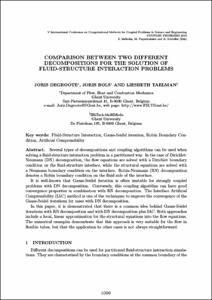Comparison between two different decompositions for the solution of fluid-structure interaction problems

Visualitza/Obre
Estadístiques de LA Referencia / Recolecta
Inclou dades d'ús des de 2022
Cita com:
hdl:2117/192672
Tipus de documentText en actes de congrés
Data publicació2013
EditorCIMNE
Condicions d'accésAccés obert
Tots els drets reservats. Aquesta obra està protegida pels drets de propietat intel·lectual i
industrial corresponents. Sense perjudici de les exempcions legals existents, queda prohibida la seva
reproducció, distribució, comunicació pública o transformació sense l'autorització del titular dels drets
Abstract
Several types of decompositions and coupling algorithms can be used when
solving a fluid-structure interaction problem in a partitioned way. In the case of Dirichlet-
Neumann (DN) decomposition, the flow equations are solved with a Dirichlet boundary
condition on the fluid-structure interface, while the structural equations are solved with
a Neumann boundary condition on the interface. Robin-Neumann (RN) decomposition
denotes a Robin boundary condition on the fluid side of the interface.
It is well-known that Gauss-Seidel iteration is often unstable for strongly coupled
problems with DN decomposition. Conversely, this coupling algorithm can have good
convergence properties in combination with RN decomposition. The Interface Artificial
Compressibility (IAC) method is one of the techniques to improve the convergence of the
Gauss-Seidel iterations for cases with DN decomposition.
In this paper, it is demonstrated that there is a common idea behind Gauss-Seidel
iterations with RN decomposition and with DN decomposition plus IAC. Both approaches
include a local, linear approximation for the structural equations into the flow equations.
The numerical examples demonstrate that this approach is very suitable for the flow in
flexible tubes, but that the application to other cases is not always straightforward.
ISBN978-84-941407-6-1
| Fitxers | Descripció | Mida | Format | Visualitza |
|---|---|---|---|---|
| Coupled-2013-89_Comparison between two.pdf | 246,2Kb | Visualitza/Obre |

